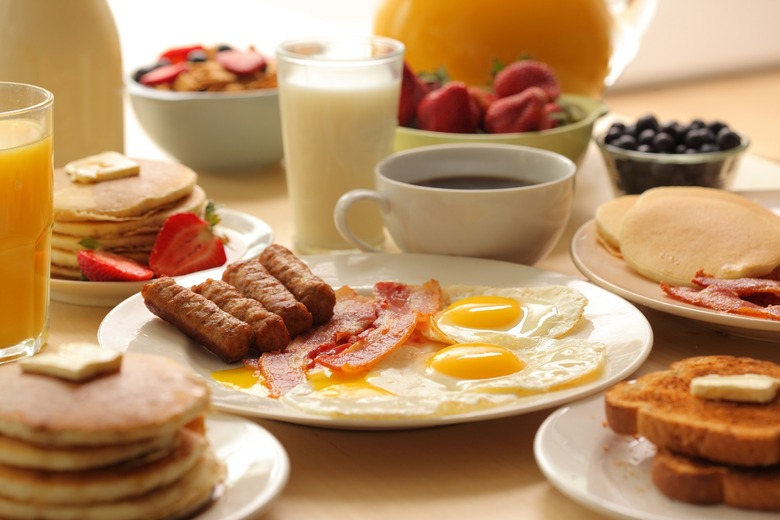Why Breakfast Took Over The Whole Darned Day
This is one in a series of stories; visit The Daily Meal Special Report: Breakfast in America: What It Is and What It Means for more.
Most meals stay in their own timeslot (or, as they say in the fast food game, "daypart"). You eat a sandwich at lunch, serve up your grilled chicken and vegetables for dinner, and reach for that ooey, gooey brownie (or, if you're more virtuous, that nice ripe apple) for a midday pick-me-up or after-dinner dessert.
But breakfast — well, that's the exception. Bacon, a longtime staple of American breakfasts, can be seen everywhere from sandwiches to appetizers to desserts and even cocktails. The sweet carbs of breakfast such as pancakes, waffles, and crêpes are an increasingly popular dessert offering. And eggs are no longer relegated to being scrambled and served alongside sausages and toast. Fried eggs are seemingly everywhere, from burgers to pizza to soups.
You can see how this breakfast obsession developed in real time. Brunch, the supposed portmanteau of breakfast and lunch that's really just an excuse to sip mimosas and eat eggs Benedict until 4 p.m., has risen above its after-church meal status and been elevated to an all-out phenomenon.
According to Google Trends, interest in brunch has traditionally shot up around Easter and Mother's Day (traditional brunch holidays) each year. But since early 2014, there's been a tremendous rise in searches for the term all year, peaking in winter 2016. (Searches for "breakfast" have risen, too, though not as much.) And, of course, there's the all-day breakfast. That search term was barely a blip on the radar before October 2015, when McDonald's launched its all-day breakfast — then it took off. Searches for all-day breakfast search trend have settled down, but it still remains a hotter topic than ever could have been conceived of just three years ago.
Once relegated to seedy 24-hour diners, all-day breakfast and breakfast foods appearing for other meals is now the norm — and mid-level restaurants that report ebbing sales for lunch and dinner have seen breakfast business increase. It's the one bright spot for many operators.
To find out how, exactly, breakfast seeped into our pop culture ethos, we need to look back to that old-style, all-purpose restaurant known as the diner. Long before McDonald's started serving Egg McMuffins 24/7, diners were scrambling, frying, and boiling eggs and serving them to patrons all day and night.
"All-day breakfast evolved from the fact that [diners] were originally serving lunches in the middle of the night, so anything goes," Richard Gutman, director of the Culinary Arts Museum at Rhode Island's Johnson & Wales University, told Van Winkle's. "There's something about the idea of eggs or waffles or pancakes for dinner (or any meal) that's very appealing."
So, why has breakfast taken over the whole darned day? The answer is surprisingly simple: People like it, so why not? When you think of the classic American breakfast plate, full of pancakes, bacon, sausage, eggs, and maple syrup, there's something there for everyone — carbs, protein, something salty, something sugary. Even without all that, breakfast has you covered. Want something savory? Eat a ham and cheese croissant. Want something sweet? Have a doughnut. Want something that's wholly and completely indulgent? Well, take your pick off the breakfast menu — morning, noon, or night — and have a field day.
No matter what the time it is, at least in America's book, it's always breakfast time.
